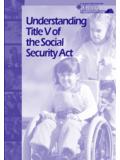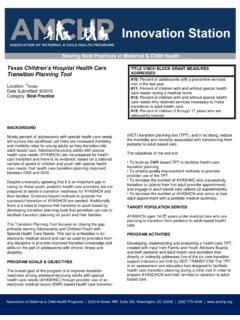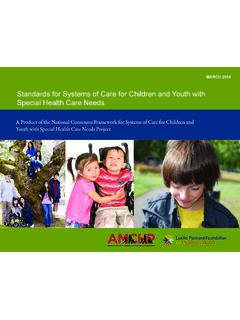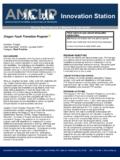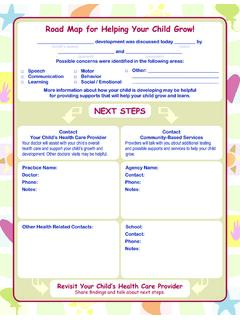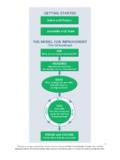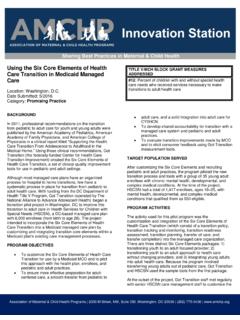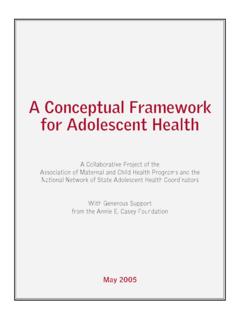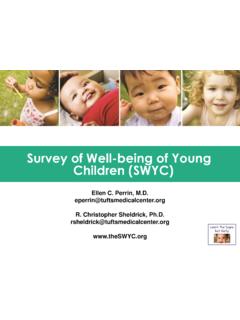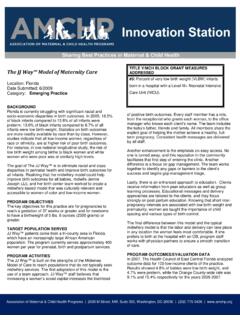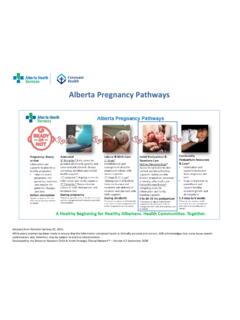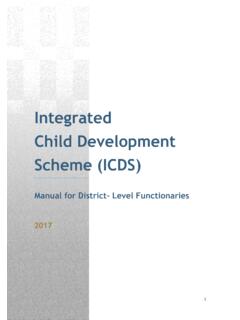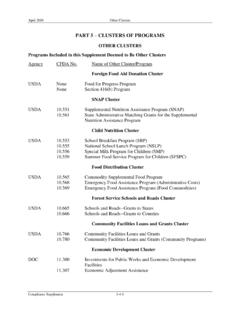Transcription of Rapid Adolescent Prevention Screening (RAAPS)
1 Innovation Station Practice Summary and Implementation Guidance Rapid Adolescent Prevention Screening (RAAPS). An Innovation Station Promising Practice Purpose: This document is intended to support MCH professionals to implement a practice found in Innovation Station. This resource provides the information needed to replicate the practice and is divided into two sections: the first section provides a high-level overview of the practice while the second section describes how to implement the practice. For additional information on any of the content provided below, please reach out to the practice contact located at the bottom of this document.
2 Section I: Practice Overview Location: Michigan Title V/MCH Block Grant Measures Addressed Category: Promising Bullying; Adolescent Well-Visit; Injury; Physical Activity; Smoking; Child Mortality; Adolescent Date Submitted: 05/2020 Mortality, Vehicle Death, and Suicide Practice Description Recognized by leading health organizations as an effective and time efficient clinical tool, the Rapid Adolescent Prevention Screening (RAAPS) is a standardized, validated youth risk Screening and health education solution developed to support professionals in reducing the risk factors impacting the health , well-being, and academic success of youth 9-24 years.
3 RAAPS. overcomes the real-world barriers of professional's time, workflow, knowledge, and skills as well as barriers such as youth honesty and engagement. Purpose According to the Centers for Disease Control and Prevention (CDC) Youth Risk Behavior Surveillance System (YRBSS), nearly 75% of serious injury and premature death in youth is a result of preventable, risky behaviors. RAAPS has been extensively tested and proven to be reliable and valid at assessing risks identified by the CDC as contributing most to preventable morbidity and mortality in youth.
4 RAAPS is the first technology-based risk identification and coaching system that was created specifically for professionals working with youth. RAAPS. digitally empathetic technology eliminates the most common real-world barriers to risk Screening : - Efficiency: completed by most youth in just 5 minutes. Professionals know key risks before they meet with youth face-to-face. - Efficacy: it has been proven that youth are more honest with a technology interface when disclosing risks than with traditional oral or paper survey methods.
5 With technology more risks are identified and youth lives improved. Plus, youth were involved with every aspect of the RAAPS development ensuring the questions, technology design, and images are relevant and engaging. Page | 1. - Digital Empathy: RAAPS takes an interactive, cutting-edge approach to technology- based assessment and coaching by dynamically embedding the core principals of digital empathy, such as concern and caring for others expressed through computer-mediated communications, into the user experience. A personalized user experience encourages youth to be more honest allowing professionals to identify those youth in greatest need and provide resources and support for care management.
6 - Insight: real time reporting provides easy access to data (identify trends, track outcomes, tailor programming). - Standardization ensures every youth are asked the same questions, the same way, every time. - Evidence-based tailored risk education is automatically generated for youth when they complete RAAPS, tailored to the risk information they shared, and health literacy features include an audio option for listening to the text as well as reading. The tailored health messages are also available to professionals at-a-glance, and use behavior- change science to help navigate difficult conversations regardless of their level of familiarity or comfort with the topic.
7 Education provided includes ideas for behavior change, statements to increase self-efficacy, and national resources. Given that brain development changes dramatically between ages 9 to 24, an older child (ages 9-12) needs questions to be framed very differently than a teen (ages 13-18) in order to understand a question and respond appropriately. In addition, risk behaviors change over time . sexual activity, unsafe driving, and binge drinking are examples of risks that tend to be age- related. To help professionals effectively address these changes, RAAPS is tailored for age- specific risks and language, with three distinct tools available in English and Spanish: Older Child for ages 9-12.
8 Adolescent for ages 13-18. Young Adult for ages 19-24. By offering the versions tailored by age, RAAPS helps ensure all youth screened are able to provide the most accurate answers possible, helping professionals connect them with the care and resources they need. Practice Foundation health Belief Model: In order to adopt health behaviors, an individual's perceptions of risk for health problems and perceived benefits of action must outweigh their perceived barriers to action. RAAPS tools are reviewed and updated biennially to incorporate the latest in evidence-based guidelines and changing trends in youth risks.
9 The type and prevalence of youth risks change over time. Vaping, texting while driving, and the number of youth struggling with anger management or carrying a weapon for protection are just a few examples of changes to the RAAPS content since its initial development in 2006. In addition, the language youth use to describe these risks changes dramatically and must be updated for relevance and engagement. Each biennial update begins with a comprehensive literature review of peer-reviewed journal publications and youth risk data from the CDC, NIH, and WHO.
10 In addition, over 3500 clinicians and professionals actively using RAAPS are surveyed to gather data on the assessment Page | 2. questions and youth responses. Updates are then reviewed by a panel of youth in order to ensure accuracy in question comprehension and relevance in language choice. RAAPS integrates behavior change science to deliver tailored evidence-based health education to risks identified by each youth. This education was developed using findings from literature reviews of health education that has been shown to be most effective at reducing youth risk.
